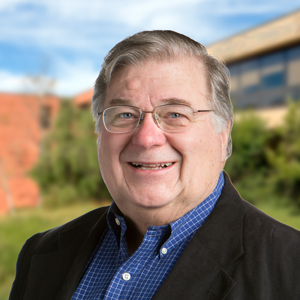Source: Interfolio F180

John Griffin, PhD
Research Focus
The Cytoprotective Protein C Pathway
Our overall goal is to combine basic lab, preclinical studies and clinical research elements as parts of a broad interdisciplinary research program with strong translational dimensions. Studies of the multiple biologic activities of the plasma protease, activated protein C (APC), have helped to define the cytoprotective protein C pathway components and their mechanisms of action. APC is a homeostatic protease that counteracts many bodily stresses and injuries, e.g., ischemia reperfusion injury such as ischemic stroke, infections that cause sepsis, and radiation injury. Protein engineering is used to establish structure-function relationships for APC and to dissect its anticoagulant activity from its cell signaling actions. One APC mutant with selectively reduced anticoagulant activity, known as 3K3A-APC, is in clinical trials for ischemic stroke. Other APC mutants are being studied for other potential indications. Research is also focused on APC receptors, including protease activated receptor 1 (PAR1) that mediates beneficial cell signaling activities as APC activation of this GPCR exhibits a remarkable pattern of biased agonism. Genetically modified mice are used for animal injury model experiments to provide proof of concept for mechanisms underlying the protective cell signaling effects of APC and APC mutants.
Blood Proteins, Lipids, and Thrombosis
Venous and arterial thrombosis contribute to morbidity and mortality for many Americans. Our laboratory is involved in long-term studies of plasma proteins and lipids that regulate thrombosis and hemostasis. Networks of mechanisms for up-regulation and down-regulation of thrombin generation or of other coagulation factor proteases must act in concert to prevent bleeding and yet avoid harmful blood clots. Among known mechanisms, the protein C pathway plasma components provide physiologic antithrombotic activity. Current research is focused on discovery of new networks, mechanisms, and molecules that contribute to regulate the "hemostatic balance", i.e., the balance between preventing bleeding while preventing excessive blood clotting (thrombosis).
Education
Ph.D. (Biochemistry), Philipps University Marburg, 1984M.S. (Biology), Justus-Liebig University of Giessen, 1980
Professional Experience
1969–1971 Fellow in Biological Chemistry (Elkan R. Blout lab), Harvard Medical School
1971–1973 Senior Research Fellow (Christian B. Anfinsen Lab), NIH
1973–1974 Staff Scientist, Service de Biochimie, Centre d'Etudes Nucleaires, Saclay, France
1974-1992 Assistant Professor, Scripps Research Institute
1992-1994 Associate Professor, Scripps Research Institute
1994-Present Professor, Scripps Research Institute
Other Joint Appointments
Adjunct Professor, Department of Medicine, University of California at San Diego
Awards & Professional Activities
2018 Earl W. Davie Symposium Keynote Lecture, Vancouver, BC, Canada2016 Sol Sherry Distinguished Lecture on Thrombosis, American Heart Association, New Orleans LA
2022 Scientific Advisory Board, Novapep Pty Ltd, Sydney Australia
2012 NIH Director's Transformative Research Award Study Section
2009 NIH Challenge Grant Editorial Review Panels: co-chair RC1 reviews July 2009, chair RC4 reviews, June 2010
2022 Scientific Advisory Board, ZZ Biotech LLC, Houston TX. (re: Scripps's drug for ischemic stroke)
2005 NIH Thrombosis & Hemostasis Study Section (4 yr appointment), Chair, 2008-2009
2005 International Society for Thrombosis Haemostasis (ISTH), Career Achievement Award
1999 Amer Soc Hematology: Subcomm on Thrombosis & Vascular Biol, Chair, 2003-2004
1988 Amer Heart Association: National Research Committee 2002-2005, Western States Affiliate, Chair Peer Review Research Committee 1988-91, Vice-Pres. for Research & Board of Directors, 1993-95
1987 ISTH, Elected Member of Scientific Standards Committee, 1987-92 (Co-chair, Protein C and Protein S Subcommittee, 1987-92)
1985 Chair of Scientific Program, Xth International Congress of International Society for Thrombosis Hemostasis, San Diego
1978 NIH / NHLBI review committees: ad hoc for various Study Sections and Hem-1 Study Section; 1961 RCA Physics & Santa Clara Jesuit Scholarships
1969 Helen Hay Whitney Postdoctoral Fellow Award
Selected Publications
Griffin, John H. Blood coagulation. The thrombin paradox.. Nature 1995, 378, 337-338.
[View]
Cheng, T.; Liu, D.; Griffin, John H.; Fernandez, J. A.; Castellino, F.; Rosen, E. D.; Fukudome, K.; Zlokovic, B. V. Activated protein c blocks p53-mediated apoptosis in ischemic human brain endothelium and is neuroprotective.. Nature Medicine 2003, 9, 338-342.
[View]
Mosnier, Laurent O.; Griffin, John H. Inhibition of staurosporine-induced apoptosis of endothelial cells by activated protein C requires protease-activated receptor-1 and endothelial cell protein C receptor. Biochemical Journal 2003, 373, 65-70.
[View]
Liu, D.; Cheng, T.; Guo, H.; Fernandez, J. A.; Griffin, John H.; Song, X. M.; Zlokovic, B. V. Tissue plasminogen activator neurovascular toxicity is controlled by activated protein C. Nature Medicine 2004, 10, 1379-1383.
[View]
Mosnier, Laurent O.; Gale, Andrew; Yegneswaran, S.; Griffin, John H. Activated protein C variants with normal cytoprotective but reduced anticoagulant activity. Blood 2004, 104, 1740-1744.
[View]
Guo, H.; Liu, D.; Gelbard, H.; Cheng, T.; Insalaco, R.; Fernandez, J. A.; Griffin, John H.; Zlokovic, B. V. Activated protein C prevents neuronal apoptosis via protease activated receptors 1 and 3. Neuron 2004, 41, 563-572.
[View]

